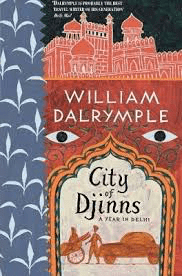
BG 2 – Book Review - August 2022
City of Djinns – a Year in Delhi by William Dalrymple
William Dalrymple peels back the layers of Delhi’s history, in a what can be called part travelogue part memoir. The book goes back in time, from the 1984 riots, to Indraprastha, the mythical city of the Pandavas. City of Djinns is William Dalrymple’s account of a year spent in Delhi, which he narrates from the heart, in a candid conversational style, that makes a full circle of Delhi in every conceivable way.
He weaves his historical narrative with the accounts of his landlords in Delhi - Mrs. Puri, his practical minded thrifty lady, Balwinder Singh - the typical Sikh taxi driver, the mali (gardener), the sweeper, the cook and the eccentric Mr Puri. One almost gets a comic effect that flows from his unfamiliarity as he learns to make sense of life in Delhi.
Dalrymple’s prime focus has been to walk through Old Delhi and dig up the history of the ruins and the narrow lanes, the people and their lives, the royalty and the social outcastes. He dwells on the significance of Delhi in Asian history and tries to find signs of the old life still breathing in today’s capital. He visits libraries and pours over hundreds of ancient books and documents. He even locates one hidden blocked pathway through some of his exhaustive research.
He uncovers historical structures that are not tourist places anymore and hence, the people of India, themselves, are ignorant about. The abandoned city of Tughlaqabad, the house built by William Fraser and several such structures are not part of a tourist’s itinerary anymore, and therefore, go absolutely unnoticed. Even for a Delhiite like me he breathes life and new meanings into structures like the Red Fort and the buildings of New Delhi in a unique style, that is neither like a historian nor like a traveller. He quotes from accounts of travellers to Delhi over different periods of time, not only talking about facts known in history text books but also about the gossip, the first-hand descriptions, the daily nitty-gritties from that era and so much more. He even gives a descriptive account of the Sufi faith as well as follows another thread where he pursues archaeological proof of whether the Mahabharata was myth or actual history. He takes us along with him on his journey around the city. He keeps moving back and forth in time, talking about the present-day Delhi too — the cultural biases, the festivities and celebrations, the marriages, the demography and how it came about. Delhi’s weather inspires a good deal of description as each chapter deals with a period in Delhi’s history, in tandem with a season of Delhi’s weather. He tries to find survivors in the present Delhi of every historical chapter he talks about. He traces the last direct descendants of the Mughals living in abject conditions in an Old Delhi haveli; the Anglo-Indians and how they fit into Indian society after the British left; and the British who had spent their childhood in India during the time of the Raj. Through these accounts, he sketches a living picture of everything he talks about. He also uncovers what has survived over the centuries — the Central-Asian unani strain of medicine still practiced in Old Delhi, the bird-fights, the dying art of calligraphy, the qawwalis at the shrine of Nizam-ud-din, the final prayer in fasting on the eve of Eid at Jama Masjid.
For me, the book has been an eye-opener. I’m sure there are countless Indians who are still in absolute ignorance of the charm of their capital city and how it has been a central force in history and shaping the future. The wonder at learning things new, the honest observations, the discoveries tinged with familiarity and the gradual foundation of a long-standing relationship between Dalrymple and the subject are what make this book truly remarkable. An excellent read – our group would highly recommend it. We rated the book 9/10
Aseema Singhal
